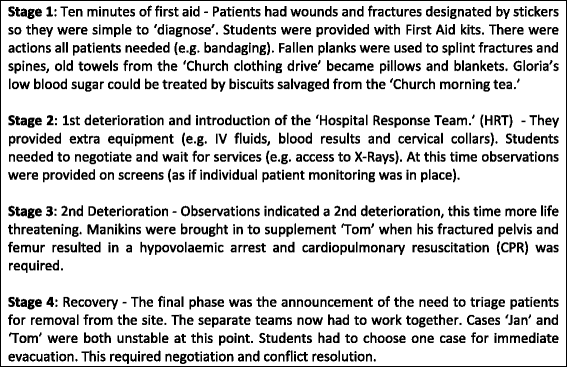A large-scale mass casualty simulation to develop the non-technical skills medical students require for collaborative teamwork
- PMID: 26956535
- PMCID: PMC4784452
- DOI: 10.1186/s12909-016-0588-2
A large-scale mass casualty simulation to develop the non-technical skills medical students require for collaborative teamwork
Abstract
Background: There is little research on large-scale complex health care simulations designed to facilitate student learning of non-technical skills in a team-working environment. We evaluated the acceptability and effectiveness of a novel natural disaster simulation that enabled medical students to demonstrate their achievement of the non-technical skills of collaboration, negotiation and communication.
Methods: In a mixed methods approach, survey data were available from 117 students and a thematic analysis undertaken of both student qualitative comments and tutor observer participation data.
Results: Ninety three per cent of students found the activity engaging for their learning. Three themes emerged from the qualitative data: the impact of fidelity on student learning, reflexivity on the importance of non-technical skills in clinical care, and opportunities for collaborative teamwork. Physical fidelity was sufficient for good levels of student engagement, as was sociological fidelity. We demonstrated the effectiveness of the simulation in allowing students to reflect upon and evidence their acquisition of skills in collaboration, negotiation and communication, as well as situational awareness and attending to their emotions. Students readily identified emerging learning opportunities though critical reflection. The scenarios challenged students to work together collaboratively to solve clinical problems, using a range of resources including interacting with clinical experts.
Conclusions: A large class teaching activity, framed as a simulation of a natural disaster is an acceptable and effective activity for medical students to develop the non-technical skills of collaboration, negotiation and communication, which are essential to team working. The design could be of value in medical schools in disaster prone areas, including within low resource countries, and as a feasible intervention for learning the non-technical skills that are needed for patient safety.
Figures




References
-
- Flin R, O'Conner P, Crichton M. Safety at the Sharp End: A guide to non-technical skills. Aldershot: Ashgate publishing; 2008.
MeSH terms
LinkOut - more resources
Full Text Sources
Other Literature Sources

